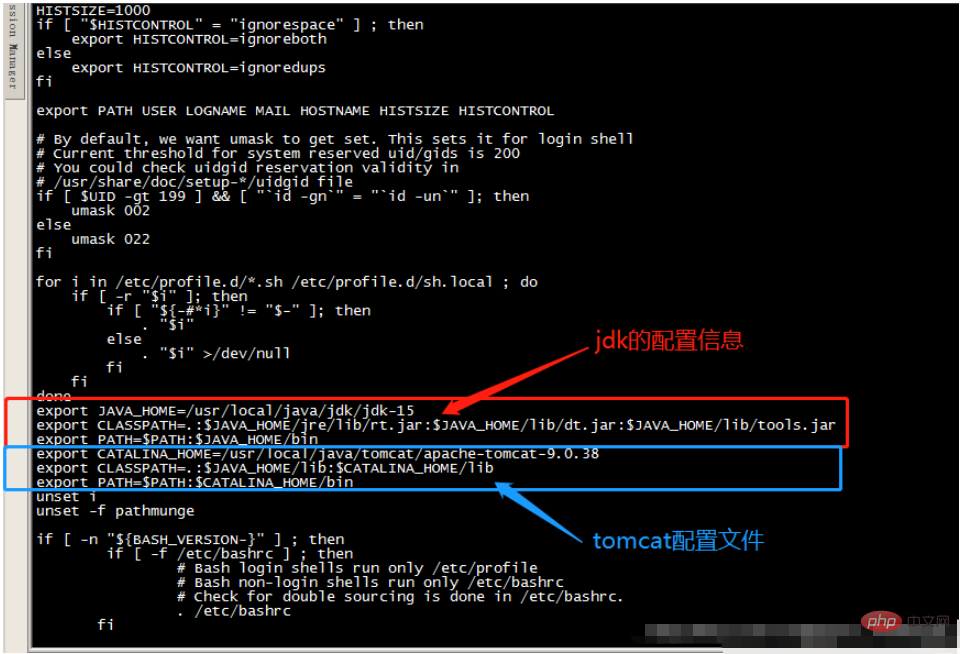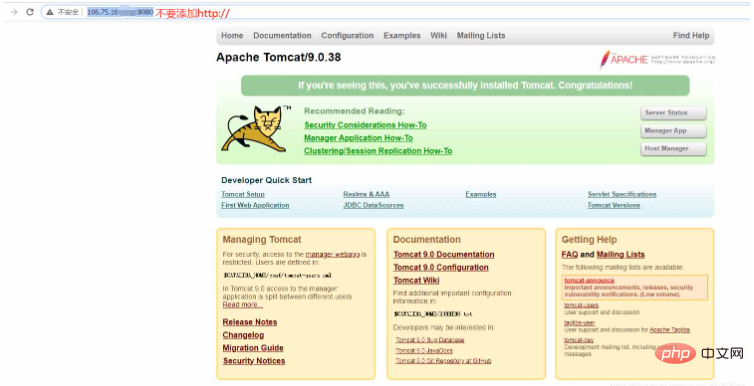cd /usr/local/java/tomcat/apache-tomcat-9.0.38/bin 进入Tomcat下的bin目录
./startup.sh Tomcat 开启命令
systemctl stop firewalld.service 关闭防火墙
cd /usr/local/java/tomcat/apache-tomcat-9.0.38/bin 进入Tomcat下的bin目录
./startup.sh Tomcat 开启命令
 Operation and Maintenance
Operation and Maintenance
 Linux Operation and Maintenance
Linux Operation and Maintenance
 How to configure the Tomcat environment in Linux system
How to configure the Tomcat environment in Linux system
How to configure the Tomcat environment in Linux system
The following steps are to deploy the jtomcat environment in the Linux system
Prerequisite preparation: successfully install the jdk environment (jdk installation steps)
Check the linux system version and download the corresponding tomcat installation package
uname -a 查看下系统信息

1. Download the tomcat installation package

2. Upload the tomcat installation package and unzip it

3. Configure environment variables
vim /etc/profile 进去profile文件
4. Enter the I key
Switch to input mode.
5. Copy the configuration information
and paste it into the profile file as shown (enter in front of unset i)
export CATALINA_HOME=/usr/local/java/tomcat/apache-tomcat-9.0.38 设置为自己的tomcat目录位置 export CLASSPATH=.:$JAVA_HOME/lib:$CATALINA_HOME/lib export PATH=$PATH:$CATALINA_HOME/bin

:wq
Save and exit:q!
Do not save and exit regardless of editing or not.
source /etc/profile 文件修改生效命令
systemctl stop firewalld.service 关闭防火墙
Copy after logincd /usr/local/java/tomcat/apache-tomcat-9.0.38/bin 进入Tomcat下的bin目录
Copy after login./startup.sh Tomcat 开启命令
Copy after login
8. As shown in the figure tomcat starts successfullyYou can access 192.168.23.282:8080 through the browser (do not add https://)systemctl stop firewalld.service 关闭防火墙
cd /usr/local/java/tomcat/apache-tomcat-9.0.38/bin 进入Tomcat下的bin目录
./startup.sh Tomcat 开启命令


./shutdown.sh Tomcat关闭命令 ./startup.sh Tomcat Tomcat 开启命令
systemctl stop firewalld.service 关闭防火墙 systemctl start firewalld 开启防火墙,没有任何提示即开启成功 systemctl restart firewalld 重启防火墙 systemctl disable firewalld.service 禁止firewall开机启动
The above is the detailed content of How to configure the Tomcat environment in Linux system. For more information, please follow other related articles on the PHP Chinese website!

Hot AI Tools

Undresser.AI Undress
AI-powered app for creating realistic nude photos

AI Clothes Remover
Online AI tool for removing clothes from photos.

Undress AI Tool
Undress images for free

Clothoff.io
AI clothes remover

AI Hentai Generator
Generate AI Hentai for free.

Hot Article

Hot Tools

Notepad++7.3.1
Easy-to-use and free code editor

SublimeText3 Chinese version
Chinese version, very easy to use

Zend Studio 13.0.1
Powerful PHP integrated development environment

Dreamweaver CS6
Visual web development tools

SublimeText3 Mac version
God-level code editing software (SublimeText3)

Hot Topics
 1375
1375
 52
52
 How to solve the permissions problem encountered when viewing Python version in Linux terminal?
Apr 01, 2025 pm 05:09 PM
How to solve the permissions problem encountered when viewing Python version in Linux terminal?
Apr 01, 2025 pm 05:09 PM
Solution to permission issues when viewing Python version in Linux terminal When you try to view Python version in Linux terminal, enter python...
 Why does an error occur when installing an extension using PECL in a Docker environment? How to solve it?
Apr 01, 2025 pm 03:06 PM
Why does an error occur when installing an extension using PECL in a Docker environment? How to solve it?
Apr 01, 2025 pm 03:06 PM
Causes and solutions for errors when using PECL to install extensions in Docker environment When using Docker environment, we often encounter some headaches...
 How to efficiently integrate Node.js or Python services under LAMP architecture?
Apr 01, 2025 pm 02:48 PM
How to efficiently integrate Node.js or Python services under LAMP architecture?
Apr 01, 2025 pm 02:48 PM
Many website developers face the problem of integrating Node.js or Python services under the LAMP architecture: the existing LAMP (Linux Apache MySQL PHP) architecture website needs...
 How to solve permission issues when using python --version command in Linux terminal?
Apr 02, 2025 am 06:36 AM
How to solve permission issues when using python --version command in Linux terminal?
Apr 02, 2025 am 06:36 AM
Using python in Linux terminal...
 How to configure apscheduler timing task as a service on macOS?
Apr 01, 2025 pm 06:09 PM
How to configure apscheduler timing task as a service on macOS?
Apr 01, 2025 pm 06:09 PM
Configure the apscheduler timing task as a service on macOS platform, if you want to configure the apscheduler timing task as a service, similar to ngin...
 Can the Python interpreter be deleted in Linux system?
Apr 02, 2025 am 07:00 AM
Can the Python interpreter be deleted in Linux system?
Apr 02, 2025 am 07:00 AM
Regarding the problem of removing the Python interpreter that comes with Linux systems, many Linux distributions will preinstall the Python interpreter when installed, and it does not use the package manager...
 Four ways to implement multithreading in C language
Apr 03, 2025 pm 03:00 PM
Four ways to implement multithreading in C language
Apr 03, 2025 pm 03:00 PM
Multithreading in the language can greatly improve program efficiency. There are four main ways to implement multithreading in C language: Create independent processes: Create multiple independently running processes, each process has its own memory space. Pseudo-multithreading: Create multiple execution streams in a process that share the same memory space and execute alternately. Multi-threaded library: Use multi-threaded libraries such as pthreads to create and manage threads, providing rich thread operation functions. Coroutine: A lightweight multi-threaded implementation that divides tasks into small subtasks and executes them in turn.
 How to open web.xml
Apr 03, 2025 am 06:51 AM
How to open web.xml
Apr 03, 2025 am 06:51 AM
To open a web.xml file, you can use the following methods: Use a text editor (such as Notepad or TextEdit) to edit commands using an integrated development environment (such as Eclipse or NetBeans) (Windows: notepad web.xml; Mac/Linux: open -a TextEdit web.xml)



